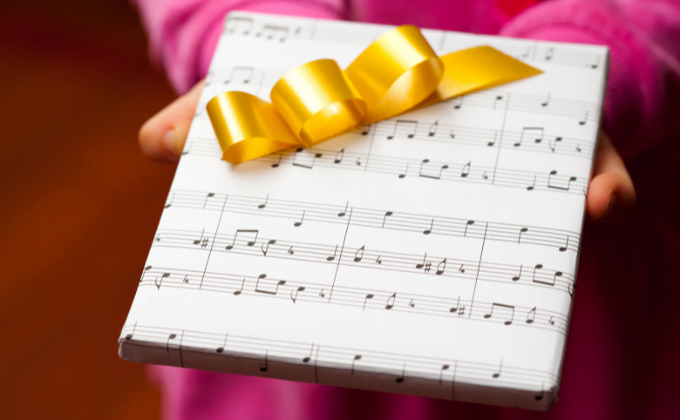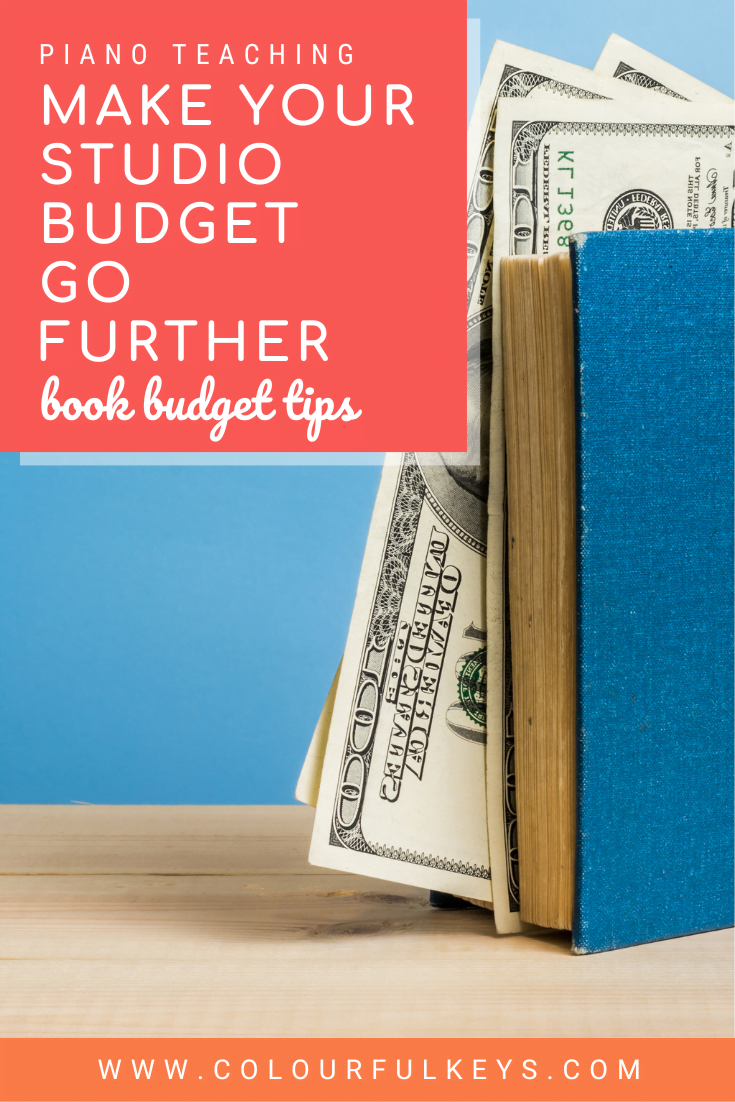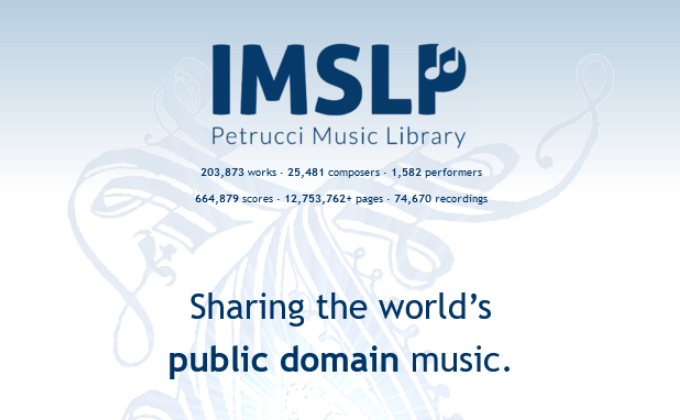
This article about stretching your music book budget was written by Gemma Wilkins. Gemma is our Community Assistant at Vibrant Music Teaching and runs a music teaching studio in the regional town of Mudgee in Australia. Teaching piano to preschoolers and primary-aged students while raising two young children has been her reality for the last five years. You can read more about Gemma and her teaching studio on her website.
How many times have you reached the end of a book or examination with a student and instantly started to plan out which book to buy next? (Hands up – totally me!)
So you place an order and wait patiently until it arrives. In the meantime, a pile of unused books sit on your bookshelf. Sound familiar?

There are definitely times when a new book purchase is absolutely necessary. But there are also many times when you may already have everything you need, right there in your studio.
A great way to make your music book budget stretch is by knowing what you have at your disposal so you’re in a better position to use it more efficiently. So why not take these 3 local tours and make your music book budget stretch even further?
Tour 1: Your Studio’s Library
First, I propose you go on an exploration of your own piano studio.
This isn’t about clearing clutter or organising. Instead, it’s about exploring the books and resources you already have but might have forgotten about.
Explore What You Have
You’ll need to put aside an afternoon (or weekend, if your collection is more like a library) and open each book. Look at the contents page, estimate the level of the pieces and think about the students who may be suitable for those books.
You may even want to make some notes or add post-its with suggested students or levels.
If you find a lot of books below the level of most of your students, consider using them for sight reading resources.
Are there performance pieces that can go in a long-term-goal category for some of your existing students? Note that down.
Don’t forget the digital collection! Studio-licensed material is usually friendly on the wallet, but it’s only budget-friendly if you remember to use it.
Create a Catalogue of Your Music Library
Making a catalogue of what you have on hand will save you time and make this tour unnecessary in the future.
This is a very ambitious goal of mine and is ongoing. But the idea of having a catalogue of my studio’s music means that when the latest exam handbook comes out or a student requests a particular piece, all I need to do is a quick search in a spreadsheet for titles and I can instantly see if I already have it.

When creating your own catalogue, include columns for things like title, composer, year, genre and approximate level so you can search and filter in different ways.
Listen to or Play Through the Books on Hand
Have you ever bought a whole book just for one particular piece inside it? Yes! It isn’t just me!
Most of the time, it gets stashed away once that piece is accomplished. That book isn’t exactly a budget-friendly addition to your music collection, is it?
Now’s the time to really explore all the options in that book.
I’ve been making it a little goal of mine to listen to or play through entire books while taking these tours. This way, I can get a feel for the pieces, their styles and their difficulty, becoming better placed to think of my music library before I go out and buy a new book for a student.
Nicola has a centralised hub page all about Planning Lessons with a section devoted to Repertoire and Resources. You should check it out!
Tour 2: Ways to Leverage Your Music Book Collection
Now that you know what you have on hand, let’s see how you can put it to good use.
Get creative!
I have always liked the idea of maximising the usefulness of the books my students already have. You may be surprised (or ashamed 🤭) to find many books in a student’s possession that have barely (or never) been used. Eek!
If you find that’s the case, pick those books back up and crack the spines open.
The more obvious use is for students to start working on those pieces. If that’s not a realistic option, however, don’t give up yet!
- Is a book too easy now? Use it for sight reading.
- Your student doesn’t like this piece or that piece? Use it to do some chord analysis, ear training or theory assignments.
- You can even use pieces to help your student learn left-hand patterns, create arrangements, inspire some improvisations or compose duet parts.
Levelling Up
When I took a tour of my studio’s music repertoire last year, I found many suitable books my students could move into straight away which had the future potential for higher-level repertoire too. One book for many levels – fab!
Charity and Gifting
During my last music book tour, I found a few duplicates of composer collections in my stash. (Do I really need 3 copies of Friedrich Burgmüller’s Op. 100?)
These were perfect to give to students.

If you include repertoire in your tuition, it’s an especially great way to get more bang for your buck and recover already sunk costs. Just add the books to their bundles.
I usually charge families separately for books, but I gave these resources away as gifts since I knew they were duplicates or were similar to resources I had. If you charge for resources separately, as I do, you may consider selling books to your students instead of gifting them. That’s totally up to you!
Make a Bit of Cash
While exploring your music studio’s repertoire library, you may find there are books and collections that simply don’t fit with your teaching style anymore.
If these aren’t suitable to give to students, then selling them may be the better option for you.
Ask your local music teachers association for their recommended second-hand sheet music marketplace (for me, that’s on Facebook.) Once you join the group, make a listing and add those books that no longer meet your needs or are in excess.
Be sure to take good photos, include details of the contents and be prepared to make a few trips to the post office.
Consider bundling similar items together. Bundles often sell more quickly than single items (especially if they have a clear category like sight reading, theory, musicianship, improvisation, technical exercises or composer collections.)
Tour 3: Budget-Friendly Music Book Options
Now that you’ve sorted through your music studio’s repertoire, you should have a pretty good idea of:
- What you can leverage from your own (or your student’s) collection
- Where the gaps are
- Whether you really do need to buy that new book
If the answer is no. 3, consider these affordable options before buying that new book directly from the publisher.
Make IMSLP Your Friend
I’m a firm believer that the best way to store my sheet music is with someone else until I need it. So I ‘store’ a lot of my scores with IMSLP, and retrieve them as I need.
The International Music Score Library Project (IMSLP) is a free website which lists sheet music available in the public domain – anything no longer under copyright protection. Copyright usually lasts at least 70 years past a composer’s death, so music on IMSLP will be at least that old.
The best bit about IMSLP is that your music book budget can stretch and stretch because all of the resources are FREE! Just make sure you account for printing.
Great ways to explore IMSLP include:
- Searching by composer
- Browsing by periods or years
- Filtering by nationality
- Appreciating and comparing scores by different editors
Second Hand
Are there music schools or music teachers in your local network who are giving away or selling duplicate copies of books? Perhaps there are some music students who are passing on old books?
Local music stores, second-hand book stores and online marketplaces such as Amazon and eBay are also excellent sources of materials.
Facebook Marketplace can be a great way to sell your existing books, but it’s also a great way to source new ones! Keep an eye out for piano teacher groups on Facebook and set up notifications for new listings of books for your piano students.
Discounted Books
Consider investing in studio-licensed books and materials. The cost is more expensive up front, but over time, you will save much more (as long as you use the book in your studio).
If you’re a member of any music teaching associations or other memberships, see if they have discount options for any composers or publishers.
Did you know that your VMT membership includes discounts for many of our favourite repertoire sources? VMT members have exclusive access to insider discounts for books from publishers and composers including Piano Safari, BlitzBooks Rote Repertoire, Forrest Kinney and Brock Chart’s My-Melodies.
Not a member of Vibrant Music Teaching? Check out what you’re missing and join today.
Reviewing Your Music Book Inventory
As a start, I recommend reviewing your music book budget at least once a year. The summer holidays work for me, as it’s a great time to order new books and replenish my library supplies.
From there, you could review any loose sheet music or books that you find lying around or that get returned by students, making sure these get added to your catalogue.
Do you have any tips for sourcing new materials or books for your studio?
Let me know in the comments. 🙂


Great ideas for using what you have and exploring new music in mindful ways!